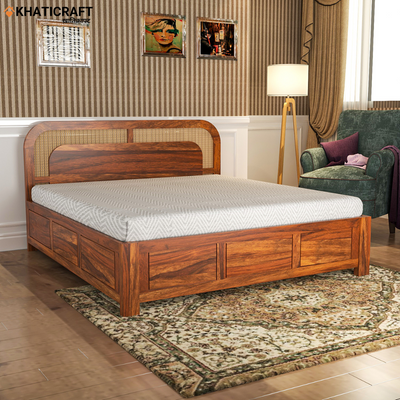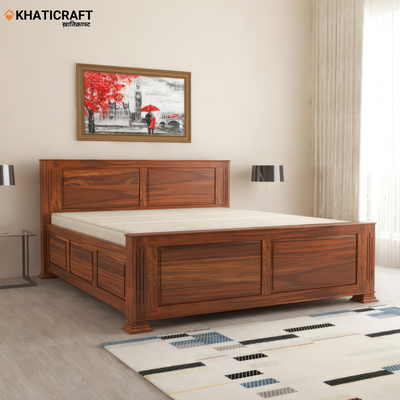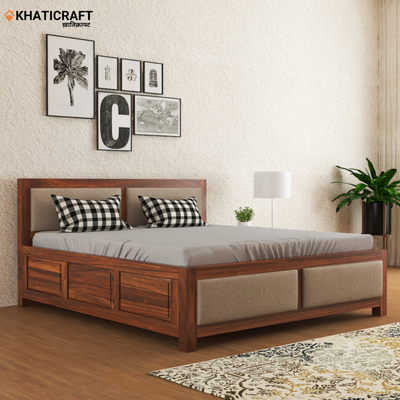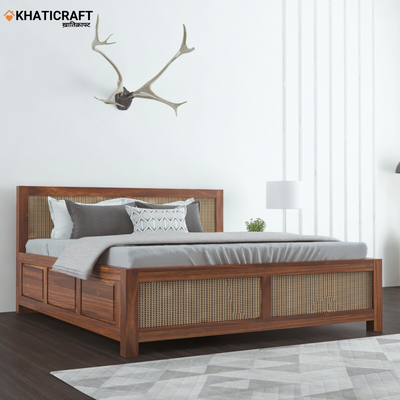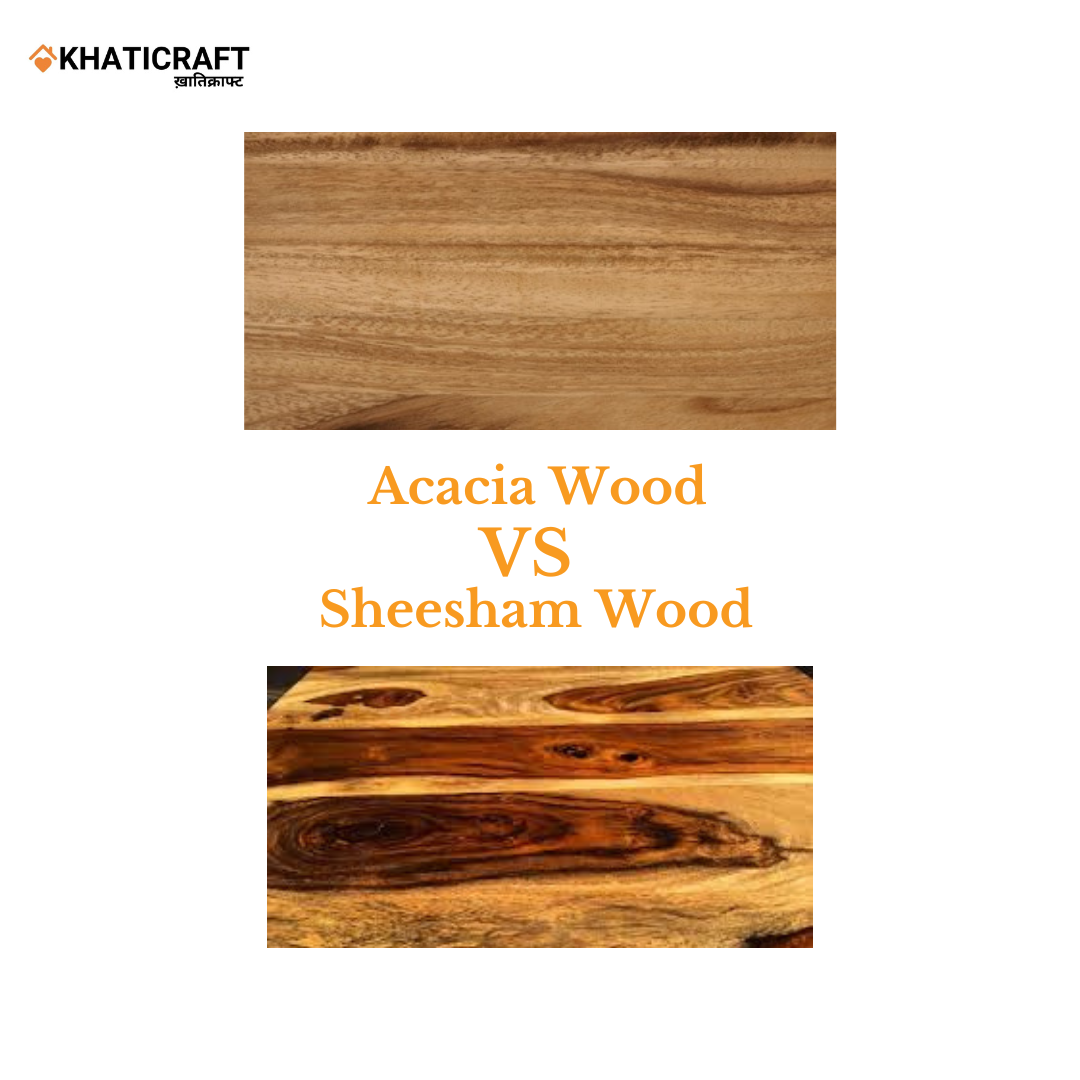Comparison Between Sheesham Wood and Acacia Wood
Wood is a timeless and versatile material used in the construction of furniture for various purposes. Among various types of wood for furniture available in the world, the two popular choices are sheesham wood and acacia wood. Each of these woods has its own unique qualities, making them ideal for different applications.
In this comprehensive comparison, we will talk about both the woods, their characteristics, benefits, Acacia wood vs sheesham wood, and drawbacks of sheesham wood and acacia wood.
Quick Comparison between Acacia and Sheesham Wood

|
Difference |
Acacia Wood |
Sheesham Wood |
|
Origin |
Acacia wood comes from acacia trees found in Africa. |
Sheesham wood comes from a tree native to Asia |
|
Appearance |
Acacia wood is usually honey-colored and have dark streaks. |
Sheesham wood mostly has a reddish- or golden-brown color with darker streaks |
|
Cost |
Acacia wood is mostly cheaper than Sheesham wood. |
Expensive |
|
Growth Time |
1-2 Years |
5-6 Years |
|
Resistant |
Acacia wood is resistant to water. |
Sheesham wood is not resistant to water |
|
Hardness |
Acacia wood has a Janka hardness rating of 2345 lbs. |
It has a Janka hardness rating of 1820 lbs. |
Sheesham Wood

Sheesham wood, or Indian rosewood, is an ideal choice in the world of woodworking due to its unique characteristics and versatile applications. This kind of wood is considered more durable and long lasting as compared to other kinds of wood. However, like any material, this wood also has its own set of advantages and disadvantages. Let's check out the pros and cons of sheesham wood.
Sheesham Wood Pros and Cons
Sheesham Wood Pros
Aesthetic Appeal: Sheesham wood or solid wood furniture is popular for its rich, dark hues and distinct grain patterns. Its reddish-brown color, often with darker streaks, gives it a luxurious and sophisticated appearance, making it highly desirable for furniture and decor.
Durability: One of the greatest features of sheesham wood is its durability. It is a hardwood that is resistant to decay and termites. This durability ensures that furniture and items made from sheesham wood can withstand the test of time.
Workability: Sheesham wood is relatively easy to work with, especially for carving and intricate designs. Woodworkers appreciate its workability, allowing them to create detailed and visually appealing pieces.
Longevity: Due to its durability and resistance to damage, sheesham wood items have a longer lifespan compared to softer woods & types of wood for furniture. This makes it a great investment for furniture that will be used regularly.
Polish and Finish: Sheesham wood takes polish and finishes well. This enables craftsmen to achieve a smooth, elegant surface that enhances its natural beauty.
Used for a variety of purposes: Sheesham wood is versatile and finds applications in various sectors, including furniture making, cabinetry, flooring, musical instruments, and decorative items. Its unique appearance makes it suitable for both traditional and contemporary designs.
Sheesham Wood Cons
Cost: The quality and popularity of sheesham wood contribute to its higher cost as compared to some other woods. Its unique appearance and durability can justify the higher price for those seeking its benefits.
Color Variation: Though the distinct color of sheesham wood is a plus point, the consistent reddish-brown hue might not be suitable for all design preferences. Some individuals might prefer a wood with lighter or more varied color options.
Weight: Sheesham wood is relatively dense and heavy & best types of wood for furniture. While this attribute results in enhanced durability, it can also make larger furniture pieces quite heavy and difficult to move.
Certainly, Sheesham wood offers a combination of aesthetic beauty, durability, and workability that appeals to many woodworking enthusiasts and professionals. Its unique appearance and versatility make it one of the most popular choices for creating high-quality furniture and decorative items.
Acacia Wood

Acacia wood is an ideal choice in woodworking due to its durability, versatility, and unique appearance. Like any material, it has its own set of advantages and disadvantages. Let's check out some of the pros and cons of acacia wood:
Acacia Wood Pros
Durability: Acacia wood is popular for its exceptional durability. It is naturally resistant to moisture, insects, and decay. This wood is an ideal choice for both indoor and outdoor applications, including furniture and outdoor structures.
Variety of Appearances: Acacia wood exhibits a wide range of appearances, from light to dark shades. Its grain patterns can vary from straight to wavy, often featuring knots and interesting textures. This diversity allows for creative and unique designs.
Versatility: Acacia wood's versatility is one of its standout features. It can be used for a variety of projects, including furniture, flooring, cutting boards, and decorative items. Its ability to adapt to different design aesthetics, from rustic to modern, makes it a popular choice.
Workability: While not as easy to work with as some softer woods, acacia wood is still moderately workable. It can be shaped, cut, and sanded effectively, allowing craftsmen to achieve desired results.
Polishing and Finishing: Acacia wood responds well to polishing and finishing. Applying stains and finishes can enhance its natural beauty and color, providing a polished and refined appearance.
Eco-Friendly Option: Acacia wood is considered relatively eco-friendly when sourced responsibly. Its rapid growth rate and the fact that it's often harvested from sustainable plantations contribute to its eco-friendly status.
Acacia Wood Cons
Weight: Acacia wood is dense and can be heavy, which might pose challenges when creating larger furniture pieces or items that need to be moved frequently.
Workability: While acacia wood is workable, its density can also make it more difficult to carve intricate designs compared to softer woods.
Potential Allergens: Like with any woodworking material, individuals might experience allergic reactions when working with acacia wood dust. Proper protective measures should be taken to minimize exposure.
Sustainability Variability: The sustainability of acacia wood can vary depending on factors such as the source and harvesting practices. Ensuring responsible sourcing is important to minimize environmental impact.
Limited Color Customization: While acacia wood offers a variety of natural colors and patterns, it might not be as suitable for those seeking more uniform or customized colors for their projects.
Prone to Scratching: While durable, acacia wood can be prone to scratching and denting, especially if not properly maintained or if used in high-traffic areas.
Detailed Comparison between Sheesham Wood and Acacia Wood
Origins and Availability
Sheesham wood, also known as Indian rosewood, is native to the Indian subcontinent. It is commonly found in India, Pakistan, and other neighboring countries.
On the other hand, acacia wood is derived from the acacia tree, which grows in regions around the world, including Africa, Asia, and Australia. Acacia wood's widespread availability makes it a more accessible option in global markets.
Appearance and Grain Patterns
Another noticeable difference between sheesham wood and acacia wood is their appearance. Sheesham wood is characterized by its rich, dark hues and striking grain patterns. It often exhibits a reddish-brown color with darker streaks, giving it a distinctive and luxurious look. In contrast, acacia wood showcases a wide range of appearances, varying from light to dark shades. Its grain patterns can be straight or wavy, often displaying knots and unique textures. Sheesham wood's consistent color and grain make it suitable for elegant and sophisticated furniture designs, while acacia's diverse appearance lends itself well to both rustic and modern aesthetics.
Growth Time
Sheesham wood is a very slow-growing and dense hardwood found in India, Bangladesh, and Pakistan. The growth cycle of this sold wood begins as a seedling for 4 to 5 years until it becomes 20 feet tall. At this point of time, the tree starts producing flowers. The maximum height of the tree can be up to 40 feet in height and its trunk can grow up to 4 feet in diameter within 40 years.
On the other hand, Acacia wood is very fast growing with a growth cycle of just 1-2 years for a tree between 10 and 15 feet tall. Similar to Sheesham, Acacia flowers are also produced when the tree reaches about 20 feet tall. But as compared to Sheesham, the Acacia tree grows much larger with heights reaching up to 100 feet.
Durability and Hardness
Among both kinds of woods, Acacia wood is the hardest wood, while Sheesham wood is harder than pine. Acacia wood is mostly used for butcher blocks, high-end cutting boards, and for several kitchen items due to its durability.
While Acacia wood is exceptionally durable; in fact, it’s that much durable that it’s often used for products such as AX handles and other tools. Acacia wood is harder in regard to Sheesham wood with a Janka hardness rating of 2345 lbs. Sheesham is a very durable wood and can last for years if taken care properly. The Janka hardness rating of Sheesham wood is 1820 lbs making it slightly softer than Acacia wood.
Workability and Versatility
In terms of workability, sheesham wood is relatively easy to work with. It responds well to carving and shaping, making it a favorite among woodworkers for intricate designs. Its workability, combined with its attractive appearance, allows craftsmen to create detailed and visually appealing pieces. Acacia wood is moderately easy to work with as well. While it may not be as easy to carve as sheesham wood, its versatility is highlighted by its ability to be stained and finished to achieve a variety of looks. Additionally, the variety of grain patterns found in acacia wood adds character and uniqueness to woodworking projects.
Applications
Sheesham wood is commonly used for furniture making, cabinetry, flooring, and decorative items. Its deep color and distinct grain pattern contribute to its popularity in creating pieces that stand out. The elegant appearance of sheesham wood often makes it a preferred choice for high-quality furniture designs that aim to evoke a sense of luxury and timelessness. On the other hand, acacia wood finds its application in a wide range of projects. Its durability makes it suitable for furniture, while its resistance to moisture makes it a prime candidate for outdoor furniture and structures like decks and patio furniture. Acacia wood's versatility enables it to cater to various design aesthetics, from rustic and farmhouse styles to contemporary and modern designs.
Sustainability and Environmental Considerations
When it comes to sustainability, both woods have their considerations. Responsible sourcing and harvesting practices are essential for maintaining the ecological balance. Sheesham wood's popularity and demand have raised concerns about overexploitation and illegal logging in some regions. Therefore, it is crucial to ensure that sheesham wood is sourced from sustainable and well-managed forests. Acacia wood, being more widely distributed, may have varying levels of sustainability depending on the region and the specific practices employed in its harvesting.
Conclusion
It would not be wrong to say that both sheesham wood and acacia wood have their distinct qualities catering to different woodworking needs. Sheesham wood's rich appearance, workability, and luxurious feel make it a preferred choice for creating upscale furniture and decor. On the other hand, Acacia wood's durability, versatility, and varied appearance position it as a versatile option for a wide range of projects, both indoors and outdoors.
While making the final decision, consider all the factors properly. To get the best Sheesham wood, visit Khaticraft, your online solid wood furniture.
Faqs
Q1: What are the main differences between sheesham wood and acacia wood?
A1: The main difference lies in their appearance and origin. Sheesham wood, or Indian rosewood, has a reddish-brown color with distinct grain patterns. On the other hand, acacia wood comes in many shades and grain patterns due to its diverse origins.
Q2: Which wood is more durable, sheesham or acacia?
A2: Both sheesham and acacia woods are durable, but sheesham wood is known for its exceptional durability making it an ideal investment for home furniture.
Q3: Which wood is better for furniture making?
A3: Sheesham wood's elegant appearance and workability make an ideal option for intricate furniture designs, while acacia wood's durability and versatility make it suitable for a wide range of furniture styles and applications.
Q4: Is sheesham wood more expensive than acacia wood?
A4: Yes, due to its durability, sheesham wood is generally more expensive than acacia wood. Also, sheesham wood furniture gives a unique appearance and enhances the overall décor of your home.
Q5: Can I use acacia wood as types of wood for furniture for outdoor furniture?
A5: Yes, acacia wood is an ideal option for outdoor furniture. The natural resistance of this wood to moisture and insects makes it a popular choice for outdoor applications like decks, patio furniture, and garden benches.
Q6: Which wood requires less maintenance, sheesham or acacia?
A6: Both woods require regular maintenance to maintain their appearance and durability. However, acacia wood's natural resistance to moisture and insects might make it slightly easier to maintain for outdoor applications.
Q7: Which wood has better workability for intricate designs?
A7: Sheesham wood is preferred more for intricate designs as it is relatively easier workability and the way it responds to carving. Its consistent grain pattern allows for detailed craftsmanship. You can get online solid wood furniture online from Khaticraft.
